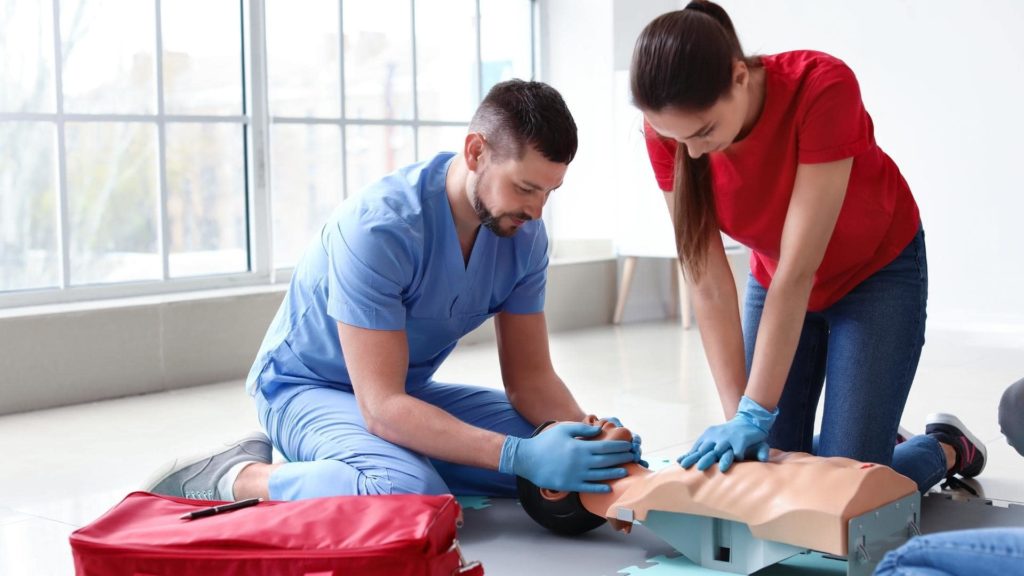The Canadian Red Cross and its partners offer a comprehensive program for candidates wanting to become First Aid instructors. Their Instructor Development Program follows a clear pathway that enables you to advance through the course, ultimately reaching the level of instructor. Get ready to learn how to become a First Aid Instructor today!
Instructor Programs
Whether you want to be a CPR, First Aid, or instructor for professional responder programs, you are assured that your training will allow you to teach people around you to help others in their work or social environment.
First Aid is an important skill to have as it teaches members of our communities how to provide skills to help save a life. Your work as a First Aid Instructor is extremely beneficial to make our world a safer place.
5 Steps to First Aid Instruction Certification
Candidates wanting to become First Aid instructors must meet certain prerequisites and complete one step before advancing to the next one. Once you receive an instructor certification, it is only valid for three years. Before your certificate expires, you will need to complete an Instructor Recertification course.
Instructor Pathway
- Checking prerequisites and evaluating skills
- Learning the fundamentals of instruction
- Focusing on specific skills of the program
- Gaining teaching experience
- Issuing of instructor certification

Course Prerequisites: To become a first aid instructor, you must meet the following prerequisites:
- You must be 18 years old or more
- You must have a Standard First Aid Certificate with CPR/AED Level C certificate
- This is a 16-hour training which must be completed through an approved training partner. This course may be completed in one of the following formats: Traditional All In-Class or Online Blended.
- To earn your Standard First Aid & CPR/AED Level C certificate, you need to pass a multiple choice exam and successfully demonstrate the complete range of skills you have learned. This Canadian Red Cross Program prepares you with the following topics:
- The Red Cross
- Preparing to respond to emergencies
- Understanding the EMS system
- Check, Call, Care
- Dealing with airway, breathing, and circulation emergencies
- First aid care for respiratory and cardiac arrest
- Wound care
- Head and spine injuries
- Bone, muscle, and joint injuries
- Sudden medical emergencies
- Environmental emergencies
- Dealing with poisons
- And more!
- Complete a separate skills assessment
- Students must show they are able to complete the skills they’ve learned in their SFA training course to ensure they feel confident enough to teach.
Instructor course and teaching experience: the instructor course is divided into four sections including both online and in-class training:
- Fundamentals of Instruction Online – complete an 8-hour online training in your own time.
- Classroom Component – 14.5 hours of in-class training focused on the application of fundamentals in First Aid & CPR.
- First Aid & CPR Discipline-Specific Component – 14.5 hours of in-class training focused on the specific skills of the program.
- Teaching Experience – There are two modules to the teaching experience component. The first module is online, taking between 30-45 minutes to complete. The classroom component of the course includes instruction from a Teaching Experience Supervisor and co-teaching alongside a certified instructor.
Register for First Aid Training
Register today for a First Aid training course and learn how to deal with emergencies and keep your loved ones safe! Check out our facilities and book your spot now.

Certification: Once the course is completed, you receive electronic certification that is valid for 3 years. As a certified instructor, you can teach Emergency First Aid and Standard First Aid for both adults and child care. You can also teach CPR courses.
First Aid Instructor Transfer Courses
Instructors from several courses may also be eligible for a transfer course. These courses are shorter than a full instructor course (20 hours), but you must already be a certified first aid instructor with another recognized organization. These include The Heart and Stroke Foundation of Canada, St. John Ambulance, The Lifesaving Society, Canadian Ski Patrol), or a Canadian Red Cross water safety instructor (WSI), or a school teacher with an education degree. You must also possess a current SFA-CPR certificate.

Additional Instructor Courses
In addition to First Aid and CPR instructor courses, you may also enroll in Professional Responder, Wilderness & Remote First Aid and Youth Leader courses. Each of these instructor courses will teach you a variety of different skills and prepare you for multiple levels of training.
Attend an Observation Session
Once you successfully complete your First Aid Instructor training, you can begin applying for instructor positions! When applying for a job with Coast2Coast, you will first need to attend an observation session. With our observation sessions, instructor candidates will attend our training courses with the lens and perspective of teaching it. They will see how our certified instructors teach a course at Coast2Coast and connect the skills they’ve learned in their Fundamentals of Instruction to the training. We recommend that our candidates take notes during their observation so they feel more prepared to teach a full course in the future.
Become a First Aid Instructor Today
Ready to teach First Aid and CPR skills? Send us an inquiry and we’ll inform you when our next First Aid Instructor course is running! If you choose to work with us, you will be required to attend an orientation after completing your Instructor course. During the orientation, instructor candidates are required to attend one of our first aid training courses and teach one skill to show they have retained the knowledge learned in their Instructor training course. Their teaching will be assessed by our instructor and discussed with the hiring manager prior to hiring. We can’t wait to help you become an amazing instructor!
Questions About Your Course?
Our team is ready to help you with your questions. Don’t hesitate and contact us today.




















No comment yet, add your voice below!